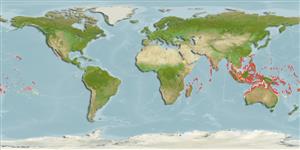Environment: milieu / climate zone / depth range / distribution range
Ecologie
marien rifbewoner; standvastig; diepte 0 - 30 m (Ref. 37816). Tropical; 25°N - 35°S
Indo-Pacific: Red Sea and the east coast of Africa (Ref. 583) to the Society Islands (Ref. 9710), as far north as Taiwan, but not Hawaii, and probably south to Tasmania.
Grootte / Gewicht / Leeftijd
Maturity: Lm ? range ? - ? cm
Max length : 19.0 cm TL mannelijk / geslacht onbekend; (Ref. 6347)
Dorsale zachte stralen (totaal): 33-38; Anale zachte stralen: 53 - 61; Wervels: 116 - 128. Eel-like, moderate to shallow body depth; maxilla free and movable; cardiform teeth present; branchiostegal membranes partly or completely united; swim bladder with thin terminal membrane or bulb; lacking enlarged dentary or premaxillary fangs, dentary diastema, pelvic fins, and swim bladder rocker bone (Ref. 34024).
This uncommon (Ref. 34024) pearlfish inhabits the coelom and respiratory trees of some holothurians, especially Stichopus chloronotus and Holothuria argus. It is apparently in competition with Jordanicus gracilis [= Encheliophis gracilis] for its preferred host H. argus. Although most occur singly, there is a tendency towards sexual pairing inside the host. Found to depths over 30 m (Ref. 9710). Stomach contents which include amphipod, shrimp and fish indicate non-parasitic, foraging habits (Ref. 6395). Leaves host at night to prey on small fishes and shrimps (Ref 90102).
Levenscyclus en paargedrag
Maturiteit | Voortplanting | Paaien | Eieren | Fecunditeit | Larven
Nielsen, J.G., D.M. Cohen, D.F. Markle and C.R. Robins, 1999. Ophidiiform fishes of the world (Order Ophidiiformes). An annotated and illustrated catalogue of pearlfishes, cusk-eels, brotulas and other ophidiiform fishes known to date. FAO Fish. Synop. 125(18):178p. Rome: FAO. (Ref. 34024)
Status op de Rode Lijst van het IUCN (Ref. 130435)
Gevaar voor de mens
Harmless
Gebruik door de mens
Visserij: van geen belang
Meer informatie
ReferentiesAquacultuurAquacultuurprofielKweeklijnenGeneticaElectrophoresesErfelijkheidZiektesVerwerkingNutrientsMassaconversie
Tools
Speciale rapporten
Download XML
Internetbronnen
Estimates based on models
Preferred temperature (Ref.
123201): 25.3 - 29.3, mean 28.5 °C (based on 3175 cells).
Fylogenetische diversiteitsindex (Ref.
82804): PD
50 = 0.5078 [Uniqueness, from 0.5 = low to 2.0 = high].
Bayesian length-weight: a=0.00102 (0.00046 - 0.00225), b=3.06 (2.88 - 3.24), in cm total length, based on all LWR estimates for this body shape (Ref.
93245).
Trofisch niveau (Ref.
69278): 3.7 ±0.63 se; based on food items.
Fishing Vulnerability (Ref.
59153): Low vulnerability (10 of 100).
Nutrients (Ref.
124155): Calcium = 75.7 [42.3, 139.8] mg/100g; Iron = 0.621 [0.363, 1.171] mg/100g; Protein = 17.2 [14.7, 19.6] %; Omega3 = 0.11 [0.06, 0.19] g/100g; Selenium = 29.3 [14.1, 62.3] μg/100g; VitaminA = 134 [44, 382] μg/100g; Zinc = 1.59 [1.09, 2.23] mg/100g (wet weight);
